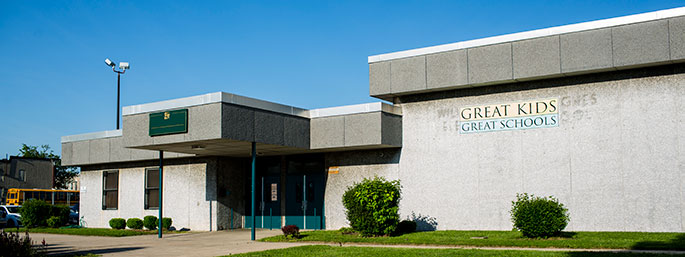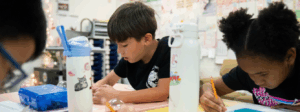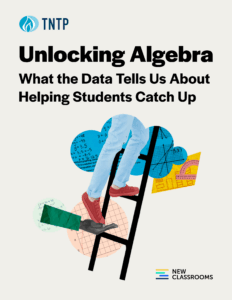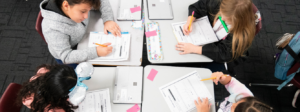If you ask 100 people to picture a baseball diamond and imagine where each player stands, they’ll all probably describe the same thing. But according to the New York Times, the traditional baseball set up started changing around 2010, based on new evidence about where batters tend to hit the ball.
If you ask 100 people to picture a school, they’ll probably all describe the same thing, too: a building with walled off classrooms, each filled with one teacher and twenty to thirty students of the same age. The difference is that unlike baseball, schools and teachers are still organized in largely the same way they were decades ago. If the third baseman doesn’t have to stand right off third base, why does a teacher still need to stand in front of 25 students?
The answer is rooted in tradition. Schools look the same largely because they’ve historically been designed the same way: built and staffed from the district central office outward. But these models are often out of sync with what we know about how students learn and the expectations for today’s workplace. Not all students learn best by listening to a single teacher lecture at the front of the room, and many careers now require people to access information independently and generate ideas and solve problems virtually and collaboratively. Yet, most American schools have made only minor adjustments to their design.
Just as some baseball teams have pushed the envelope by using data to place their defenses more strategically, across the country, there are districts and charter networks responding to these changes and beginning to do things differently. At TNTP, we’re starting to think about how to support innovative school design, so we’re chewing on three key questions that need to be answered to build schools that start from students, rather than central offices:
1. What do students need? Who’s at bat?
Teams play defense differently against a powerhouse hitter than a pitcher who is likely to bunt. The stats dictate where the defense plays on the field. Similarly, designing a school, whether it’s brand new or a turnaround, requires figuring out what the students there really need. For some students, the traditional school model with some updates and adjustments still works well. But what about students who, for example, learn better in a project-based setting or who may struggle with writing, but understand advanced concepts in science and need more challenging work? While many needs are common to most students (like effective teachers), there may be some that are more critical than others for a given group of kids.
2. What’s the plan to get students what they need? What’s the right defensive strategy?
Teams use other information—who’s on base, the score and how many outs there are—to determine the best defensive strategy for that situation. In a school setting, once students’ needs are determined, an instructional model should be determined to make sure those needs will be met. Would a blended learning model work? Or an expanded school year?
At Carpe Diem Meridien in Indianapolis, no two students are taking the exact same course load. As teacher Josh Woodward explains in Education Week, students’ course loads are determined by their instructional needs in each subject, as well as their areas of interest. Students and teachers have one-on-one and small group time to work on collaborative projects that bring their digital curriculum to life.
At Generation Schools, students have up to 30 percent more hours in the school year, compared to most traditional school models, and teachers have a notably reduced course load and a minimum of ninety minutes per day for collaborative planning. Match charter schools incorporate a high dose of one-on-one tutoring into every student’s school day. A Colorado district abandoned grade levels to move toward a competency-based model that’s more closely aligned to their immediate learning needs. All of these models are examples of districts and charter networks getting creative with school structure to put students’ unique needs first.
3. Who can get students what they need? Who’s on first? And second?
Some personnel are more effective in different situations—that’s why baseball teams have closers. A typical school district spends a majority of its budget on personnel. But different instructional models require different personnel, and if districts can allocate budgets based on the instructional model rather than the number of students in the building, there’s more room for innovation. A blended learning model might mean fewer teachers are required to reach students, because students divide their time between digital and in-person learning. The Match approach requires additional tutors. At the Academies of Nashville, Metro-Nashville Public Schools’ Career and Technical Education program, students spend time learning from professionals in various practical and technical fields.
In addition to staff, there are considerations around how much time should be allocated for different activities (and for the entire day), what materials are needed to deliver on the instructional model, and what the school space should look like, to name a few. There’s no reason for these to be uniform from school to school.
*
Baseball has been slow to change over time. And in some ways, this is a good thing. We love the game because of its traditions. In the same vein, the traditional school design model still has some advantages: Centralized district bureaucracy tends to be fairly stable, for example. But its biggest advantage is near-universal social and cultural acceptance—that very fact that everyone thinks of the same thing when they hear the word “school.” The real challenge is that most of us literally cannot imagine the alternatives. Like baseball, American public schools are treasured institutions that, for most of us, go back to our childhoods, so we shouldn’t expect that changing them will be easy: The anxiety that comes with upending a set of deeply ingrained expectations and values is genuine. But for school design to take significant leaps, we have to confront that.
Now is the time to do so. Data has done a lot for the game of baseball. Likewise, the past century has taught us a lot about how students learn and teachers teach, and about the best use of technology in aiding that process. As we move forward, districts will need to adapt to support a variety of schools. And they’ll have to grapple with big questions, like how to get parents, teachers and students to embrace changes in what the school experience looks like, how to remain flexible so schools and classrooms can continuously adapt over time, and how to address the urgent instructional needs of students while helping future and current teachers transition to new ways of teaching.
If America’s pastime can evolve, though, surely our schools can too.







